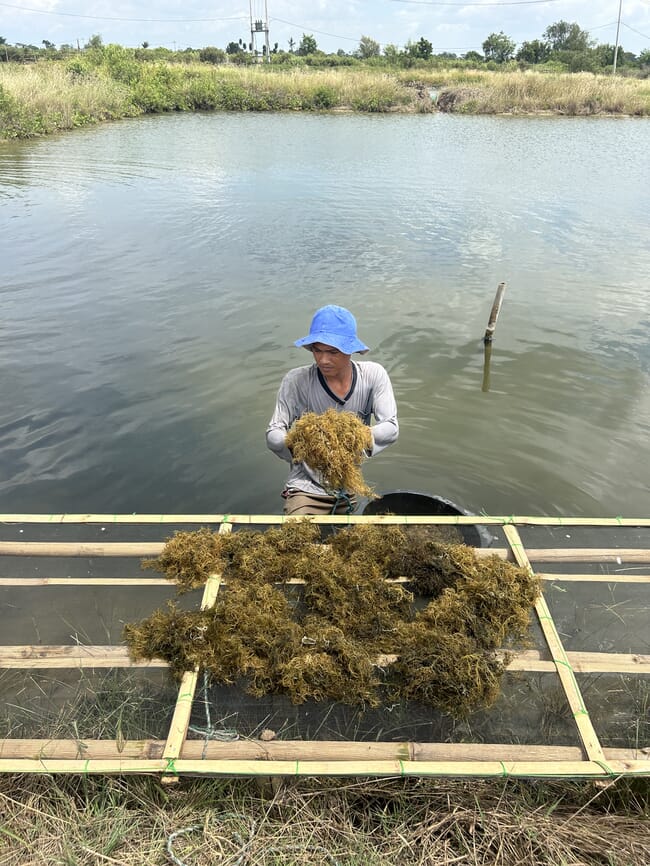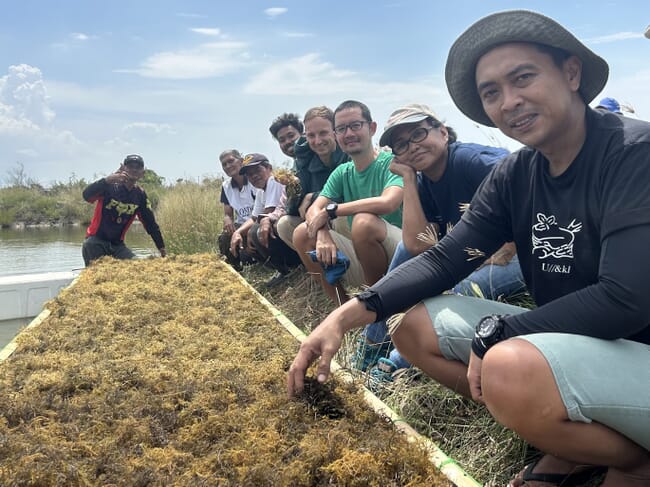
© Sambung Asa
Derived from red seaweeds like Gracilaria and Gelidium, agar is often used in baked goods like donuts, jellies and other forms of confectionery. It is also a common base material for seaweed bioplastics startups, many of whom are hoping to scale up soon.
Market sentiment is positive, according to one Indonesian agar producer: “In our traditional markets of Western Europe and Japan volumes are growing. We are also seeing increased demand from emerging markets like Turkey, Poland, India and Malaysia.”
Nonetheless, the company’s director is worried. “Making agar produces a lot of waste. When we started our factory several decades ago, there was no one around. Set between fields, we could distribute our leftovers as compost to the farmers. Now our factory is surrounded by houses. We are running out of options.”
Water is another issue. Producing a kilogram of agar uses hundreds of litres of fresh water, and water shortages are now a recurring reality for the factories’ surrounding inhabitants during the dry season.
Finally, rules from the European Union are becoming ever stricter, as the agar company director explains: “Buyers ask us where our seaweeds come from, if we can prove they have been farmed sustainably. We can’t do that, we buy from middle men; it’s too complicated for us to deal with hundreds of small farmers. And how should we prove they are not using chemical fertilisers? They all use them.”
As issues around waste, water and regulations have piled up, innovators have started to work towards alternative solutions.

Sustainable pond farming
On the northern coast of West Java, Sambung Asa is working to recover abandoned shrimp ponds. As co-founder Yudhistira Wiryawan explains: “Intensive fish and shrimp farming – where up to 60 percent of the feed goes to waste – has significantly lowered the water quality in this area. The carrying capacity of this land for aquaculture is no longer there; only seaweeds and hardy, low-value fish like tilapia can survive here now. By growing seaweeds responsibly, we hope to improve the water quality again, which should also bring jobs back to the area.”
To avoid the need for fertiliser, Sambung Asa co-cultures Gracilaria with milkfish. Most importantly, the company espouses a data-backed approach, with regular measurements to replace the current gut instinct method. As Wiryawan sees it: “Seaweed farming doesn't need expensive equipment. But why is it not working well? It’s often a lack of knowledge about what’s going on in the water. There is a data gap. That’s what we’re trying to build up now.”

© Sambung Asa
Novel ideas around processing
On the processing side, Australian startup Uluu is working to build their first factory to produce a plastic alternative from Gracilaria seaweeds in Sidoarjo. To avoid the waste and water issues the first generation of seaweed processors are struggling with, Uluu uses saltwater fermentation. Co-founder Julia Reisser explains: “At scale, rather than washing and drying the seaweeds with freshwater, we can wet mill that seaweed and then extract what we need. We don’t use any harsh chemicals or solvents in that process, it’s all water-based. And then we feed seaweed sugars to our microbes to create a natural polymer that can replace fossil plastic, while remaining biodegradable.
Jakarta-based bioplastics startup Ijo
has a similar approach, using a saltwater wash and a micro-organism. The difference, according to co-founder Rahadiyan Dewangga, is capital. “We are bootstrapped. Biotech in Indonesia is something local investors often don’t understand yet. And foreign investors tend to think Indonesia is too risky. So we are looking at creating our own seaweed food products in order to wrap them in our seaweed packaging, eaten with our own seaweed-based cutlery. We think it might be easier to find revenue there and grow organically.”
Taking agar in a new direction
Lino Paravano founded Java BioColloid in 2008 to focus on innovative agars and carrageenans and distinguish them from cheaper Chinese mass production. He thinks Indonesia’s seaweed processors ultimately need to move away from agar extraction entirely, and towards embracing the nutritional value of the whole seaweed biomass, which has the added benefit of reducing waste and chemical usage.
“It is difficult to compete with the price and controlled conditions of synthetic fermented hydrocolloids like gellan gum and xanthan gum,” Paravano says. “Of course, at the moment agar and carrageenan still have their unique capabilities. But a lot of money is being poured into these synthetics, and I believe they will one day be able to displace agar and carrageenan.”
Java BioColloid already sells a dietary fibre and texturiser without E-numbers that does not rely on extraction but instead uses the whole seaweed. Research is ongoing to process the seaweed completely without chemicals, which would allow the company to preserve all the nutrients and gain organic certification.
As Paravano concludes: “In 20 years time, I don’t see us making ingredients any more. We will produce ready-to-eat seaweed-based whole foods.”




